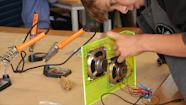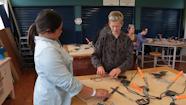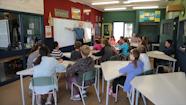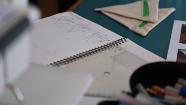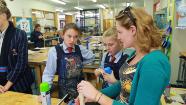Christine Elder and Stephen Newnham share insight into seamless tracking of progress.
Tracking progress in a technology centre
Transcript
Christine Elder: We do constantly track progress with students. Our students come with very little prior knowledge so we start really at level one and quite quickly work our way up. It’s just trying to keep all the information together in one spot. In the last couple of years we’ve been using App T and we just got together on the phone and spoke about what we wanted. We wanted the strands in it, we wanted opportunity for oral recording, we wanted a place that we could put photos, and we’ve got the key competencies in there too.
Halfway through the year we swap classes, and so we can pass the app over and then pick each other’s up. You can read through and have a look. Actually, this is our second year with it and when I go through it now, I can actually flick back. It’s report time at the moment, I can go back to last year and just get the big picture of that student. When you’ve got large numbers, it’s wonderful.
I’ve only really just started using the recording app. Up until recently, our evidence was mainly from written work from students but now there are other opportunities, other ways to do it. When they year eights finish, their results all go through to the high school. I mean, when we have our technology meetings, we talk about different students because all the students they talk about, we’ve taught. Then you can fill in little bits and pieces, we’ve tried this or whatever and it’s excellent, it is seamless.
Stephen Newnham: One of my focuses this year is in junior technology, year nine and year 10. We can build up a very good picture of where they’re at with their curriculum and their practical skills as well before they even enter into year nine which is just invaluable, you can’t even put a price on that type of information.
Also, I get the ability to come down here and form a relationship with these students. They know who I am before they even walk into that module. So even though it’s a six week module, they get the most out of that and I get to really know those kids a lot better than I would normally. We have a shared vocabulary, a lot of the bookwork that they’re seeing is very similar.
More importantly, they’re very aware of what their goals are in terms of curriculum levels and what that means to be working at curriculum level, what it means to be working at above their curriculum level, what the different criteria for the curriculum are asking. All of that is pretty much seamless so that, again, by the time that we see them, the types of conversations that we’re having are learning conversations. They’re not having to reinvent the wheel and tell them all about the curriculum all over again.
Related videos
Technology and science work well together (04:39)
Steve Jeffares and Ronnie McHale share how their students deepen conceptual understandings through integrating multiple knowledge bases.
A broad technology programme for year 7–8 (02:00)
Steve Jeffares and Brenda Whycherley inspire confidence in their students by offering a broad programme.
High expectations in years 7–8 technology (03:57)
Steve Jeffares shares how he inspires students to develop a love of learning.
Will my design for an organiser work? (02:02)
Two year 8 students describe their functional modelling of their designs for organisers.
Will my design for a mirror work? (04:06)
Year 8 students talk about the functional modelling of their designs for mirrors and how they are fulfilling the brief....

